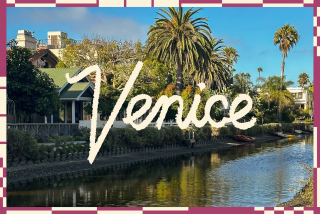Innovation in paradise
In a noble attempt to convey what Venice once was and now is, writer Michael Webb and photographer Juergen Nogai combine forces to show and tell the area’s evolution.
Beginning as a gritty working-class area and seaside haven for struggling young artists lured by sea breezes, a bohemian lifestyle and low rents, Venice was home to the young Edward Ruscha, Billy Al Bengston, Larry Bell, Laddie John Dill and Chuck Arnoldi, among others.
Adventurous architects including Frank Gehry soon joined the community and established their own homes and offices. As real estate prices soared, Venice became a kind of laboratory for architectural innovation, with multimillion-dollar homes rising where the blue-collar bungalows used to sit.
The book is primarily a photographic look at the residential architecture that has risen along the canals and walk streets of Venice, turning it from a low-key ‘hood to a high-density living history of Modern design.
The trouble in this paradise is the limitation of space. “The typical Venice house is a pocket-size clapboard or stucco bungalow on a thirty by ninety foot lot,” Webb writes. “As site values climb to $1 million and more, these cottages which define the modest and intimate character of the community are being torn down and replaced.”
Hidden behind that understatement is a reality that can’t be ignored. Today, Venice homeowners tend to build as big as zoning regulations will allow. This can lead to a community of big homes on small lots, all trying to outdo one another in their architectural vocabulary.
In fact, Venice could be looked at as a sort of ongoing un-juried competition, with many of the best up-and-coming architects and some of the older greats all vying to find the most creative solutions to narrow, deep lots, and building homes that offer maximum light, air and privacy.
There’s Gehry’s beachfront home for writer-director Bill Norton and his family, with a top-floor study that mimics the lifeguard station it looks out on. And architect David Hertz’s glass, steel and concrete house for the Thomas Ennis family, with a pneumatic glass elevator and balconies cantilevered toward the beach.
Architect Steven Ehrlich wrapped a wall of translucent, white, acrylic fiberglass around his corner compound with a center courtyard. At night, the wall captures shadows of those passing by.
Architecture buffs and others will enjoy Nogai’s excellent photos; he’s a longtime associate of architectural photographer Julius Shulman. But nothing can beat a walking tour of Venice to see it all for yourself.
-- Bettijane Levine
More to Read
Sign up for our Book Club newsletter
Get the latest news, events and more from the Los Angeles Times Book Club, and help us get L.A. reading and talking.
You may occasionally receive promotional content from the Los Angeles Times.






